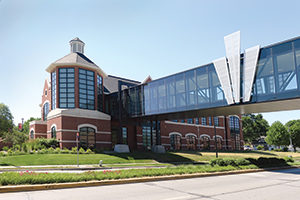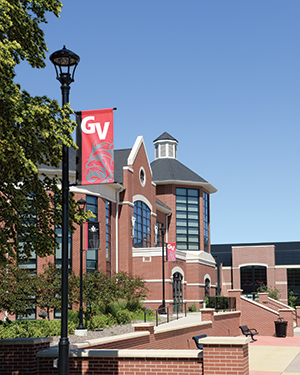
Writer: Mary Challender
Photographer: Duane Tinkey
Grand View University President Kent Henning can’t hide his passion for the east-side institution.
He wears it on his sleeve.
And on his shorts and socks and probably his ties too.
“I’m not sure he owns much that doesn’t have Grand View on it,” says his wife, Carole. “He’s the ultimate fan for those Grand View kids, whether it’s in the classroom or on the field of play.”
A beefy guy who is often mistaken for a coach, Henning has devoted the past 16 years to guiding Grand View’s metamorphosis from a run-down commuter college with 1,400 students, just a few hundred of whom lived on campus, to an inviting university with 2,200 full- and part-time students from 30 states and 17 countries, including more than 800 students living in residential housing.
The physical rebirth Grand View has undergone under Henning’s leadership is obvious to anyone driving down East 14th Street, from the Charles S. Johnston Wellness Center to the Grand Central walkway and plaza to the four new student residences that include suites and apartments. The centerpiece is the broad 156-foot skywalk that connects the recently completed Rasmussen Center with the dramatically remodeled and expanded Student Center, the culmination of a $60 million building campaign launched in 2004 that nearly doubled the footprint of the campus.
Even the name has changed, from Grand View College to Grand View University, to reflect the addition of graduate programs in organizational leadership, nursing, education and sports management.
“I remember 20 years ago, maybe 25, when Grand View College wasn’t very well thought of in the Des Moines community,” says Gary Steinke, president of the Iowa Association of Independent Colleges and Universities. “Then Kent arrived. He’s taken that institution to a whole different level, and it’s all because of his vision and his desire to put Grand View on the map.”
Literally.
“In the past, you could drive down East 14th Street and miss Grand View,” says wrestling coach Nick Mitchell, acknowledging this actually happened to him. “About 15 years ago, someone hosted a wrestling camp at Grand View, and I probably passed it three times and couldn’t find it.”
Perhaps more important than the bricks-and-mortar changes, however, has been the change in mindset that Henning brought with him when he became Grand View’s lucky 13th president in January 2000.
“When I arrived, I think many people on campus were having this conversation about what student market we should pursue to survive as a college,” the 58-year-old Henning says. “I felt that wasn’t the right conversation.”

Educational Community
A first-generation college student who grew up in the small farming community of McGregor, Iowa, Henning’s views on higher education were shaped by the four years he spent as a student at Wartburg College in Waverly, an experience he says was “transformational.” So when Henning took the helm at Grand View, his focus was on creating an educational experience centered on human development rather than economic advancement—not exactly what you’d expect from a guy with an MBA from Duke University.
Henning wanted Grand View to be a place where students would be proud to put down roots, a campus where students would be eager not only to learn but to live and socialize and become part of a community. Henning wanted to give people a Grand View they could cheer for.

The Rasmussen Center
At the time, Grand View had seven athletic programs with a total of about 175 participants. With Henning’s backing, those numbers have climbed steadily to 700 student athletes across 25 athletic programs. Grand View can now brag that it has national champion football and wrestling teams, but it also offers bowling and competitive dance.
By all accounts, Henning is a regular in the stands, a low-key cheerleader sporting the latest red Grand View swag the school’s coaches gave him.
“He’s the president, but he’s accessible,” says Mitchell, the wrestling coach. “Not only with the staff members but with the students too. He knows these guys; he knows their stories. When we go to meets, he finds out where the parents are going to eat dinner and he goes and hangs out with them. He’s definitely a professional, but he doesn’t hold himself above everyone else. People relate to him, and when he has a vision or has an idea, people buy into it because they trust him.”
Carole Henning says her husband’s support isn’t so much about pursuing championships as it is celebrating the “soft skills” that students learn when they’re part of a team. “He’s the poster child for what he wants at Grand View,” she says, “that kids who come from a certain background can move up in the world because of their education and experience. He’s that guy.”

The Student Center
Financial Support
To make the massive changes he envisioned for Grand View a reality, Henning had to inspire an unprecedented level of financial support from alumni and other donors. But Carole Henning says her husband, an introspective person whose idea of relaxation is taking a long Sunday bike ride alone, is about as far as you can get from the high-pressure super salesman type.
“Fundraising is very much about the psychology of philanthropy,” she says. “If all you do is talk as a fundraiser, you’re not going to find out what is going to motivate that person to buy into your cause. He’s a super good listener, my kids would tell you. We often joke at home that he knows people so deeply that he understands where people are going to go before they do.”
One thing that hasn’t changed a lot in Henning’s time at Grand View is the student population the school attracts. Roughly half of Grand View’s graduates are the first in their family to complete a bachelor’s degree, and almost all need financial assistance. Some 20 percent are minority, making Grand View one of the most ethnically diverse four-year institutions in Iowa. Today students from a wider cross-section of society are attending colleges and universities than 20 years ago, and Henning believes Grand View is uniquely equipped to help those students succeed.
“We are an important part of the higher education landscape today,” he says. “We surround students with lots of attention and help them grow not just academically but physically and spiritually as well. In many ways, we’re better equipped to serve as the pathway to education for many students than many of the large publicly funded universities.”
If there’s one area Henning would like to see Grand View improve in, it’s the debt load carried by its students. Although Grand View, which costs $31,070 per year with room and board, gives financial aid to a whopping 99 percent of its students, student need is high, as shown by the 40 percent of students who receive Pell Grants. As a result, the debt carried by the average Grand View student is among the highest in the state.
Pricing Guarantee
To attack this problem, Grand View has replaced charging per semester hour—a system used by most colleges and universities—with a four-year pricing guarantee offered to incoming freshmen, along with a breakdown of how much they will need to borrow and what their payments are likely to be following graduation. Coaching and financial literacy education are also provided.
“He’s trying to create at Grand View University the best possible environment for learning at the cheapest possible cost,” says Steinke, of the Iowa Association of Independent Colleges and Universities. “By keeping on that sort of path, they’ve emerged as one of the best private colleges around. Grand View doesn’t have a law school; they don’t have a pharmacy school. They’re able to really focus on undergraduate education, and that gives them a niche in the Des Moines area.”
One thing Henning is confident of is that students leave Grand View well prepared to take that next step in life. In 2015, 99 percent of graduates were placed in jobs within six months of graduation, he says, with 92 to 93 percent of those being what he would consider “successfully placed.”
“While I’m proud of the buildings and athletic teams and academic successes, in the end I’m most proud of the fact that thousands of students have gotten their degrees while I’ve been here,” he says. “I know this may sound trite, but I put in the 60- to 80-hour workweeks so our students can have their lives changed and transformed in the same way mine was at a similar institution.”





